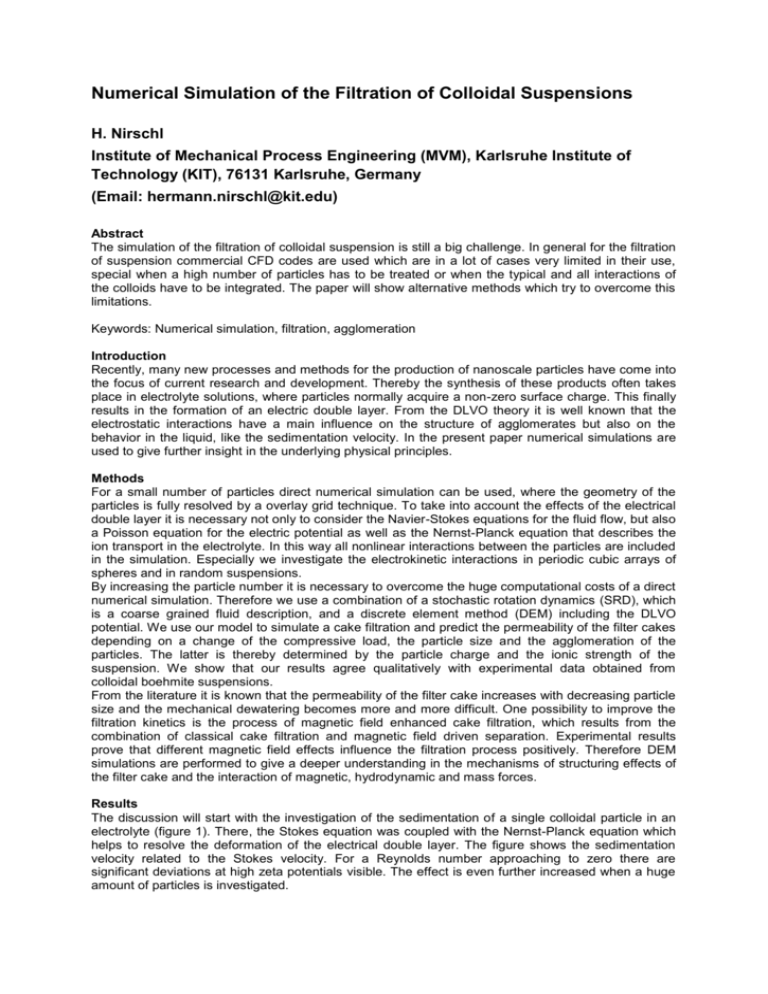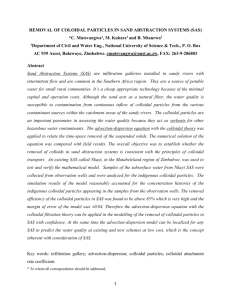abstract28
advertisement

Numerical Simulation of the Filtration of Colloidal Suspensions H. Nirschl Institute of Mechanical Process Engineering (MVM), Karlsruhe Institute of Technology (KIT), 76131 Karlsruhe, Germany (Email: hermann.nirschl@kit.edu) Abstract The simulation of the filtration of colloidal suspension is still a big challenge. In general for the filtration of suspension commercial CFD codes are used which are in a lot of cases very limited in their use, special when a high number of particles has to be treated or when the typical and all interactions of the colloids have to be integrated. The paper will show alternative methods which try to overcome this limitations. Keywords: Numerical simulation, filtration, agglomeration Introduction Recently, many new processes and methods for the production of nanoscale particles have come into the focus of current research and development. Thereby the synthesis of these products often takes place in electrolyte solutions, where particles normally acquire a non-zero surface charge. This finally results in the formation of an electric double layer. From the DLVO theory it is well known that the electrostatic interactions have a main influence on the structure of agglomerates but also on the behavior in the liquid, like the sedimentation velocity. In the present paper numerical simulations are used to give further insight in the underlying physical principles. Methods For a small number of particles direct numerical simulation can be used, where the geometry of the particles is fully resolved by a overlay grid technique. To take into account the effects of the electrical double layer it is necessary not only to consider the Navier-Stokes equations for the fluid flow, but also a Poisson equation for the electric potential as well as the Nernst-Planck equation that describes the ion transport in the electrolyte. In this way all nonlinear interactions between the particles are included in the simulation. Especially we investigate the electrokinetic interactions in periodic cubic arrays of spheres and in random suspensions. By increasing the particle number it is necessary to overcome the huge computational costs of a direct numerical simulation. Therefore we use a combination of a stochastic rotation dynamics (SRD), which is a coarse grained fluid description, and a discrete element method (DEM) including the DLVO potential. We use our model to simulate a cake filtration and predict the permeability of the filter cakes depending on a change of the compressive load, the particle size and the agglomeration of the particles. The latter is thereby determined by the particle charge and the ionic strength of the suspension. We show that our results agree qualitatively with experimental data obtained from colloidal boehmite suspensions. From the literature it is known that the permeability of the filter cake increases with decreasing particle size and the mechanical dewatering becomes more and more difficult. One possibility to improve the filtration kinetics is the process of magnetic field enhanced cake filtration, which results from the combination of classical cake filtration and magnetic field driven separation. Experimental results prove that different magnetic field effects influence the filtration process positively. Therefore DEM simulations are performed to give a deeper understanding in the mechanisms of structuring effects of the filter cake and the interaction of magnetic, hydrodynamic and mass forces. Results The discussion will start with the investigation of the sedimentation of a single colloidal particle in an electrolyte (figure 1). There, the Stokes equation was coupled with the Nernst-Planck equation which helps to resolve the deformation of the electrical double layer. The figure shows the sedimentation velocity related to the Stokes velocity. For a Reynolds number approaching to zero there are significant deviations at high zeta potentials visible. The effect is even further increased when a huge amount of particles is investigated. Figure 1: Sedimentation velocity of a single particle depending on Reynolds number with the zetapotential as a parameter The disadvantage of the methods based on the continuum theory is that the interactions cannot be resolved down to the molecular level. For this reason a SRD method was implemented where the agglomeration and the filtration of a colloidal suspension was simulated. Figure 2 shows a typical result of such a simulation. The simulations have all been validated with experiments. Figure 2: Porosity depending on zetapotential for the filtration of a colloidal suspension Conclusion The paper will show that there exist a branch of simulations tools which go far beyond the scope of usual CFD codes. They help to understand the physical effects of the filtration and separation of fine particles but they are not commercially available. This means that a lot of development effort is necessary to get real and trustful results out of such simulations. References Schäfer B., Nirschl H. (2008) Physicochemical influences on electrochemical transport in compressible packed beds of colloidal boehmite particles, Journal of Colloid and Interface Science 318, 457-462 Keller F., Feist M., Nirschl H., Doefler W. (2010) Investigation of the nonlinear effects during the sedimentation process of a charged colloidal particle by direct numerical simulation, Journal of Colloid and Interface Science 344, 228-236








